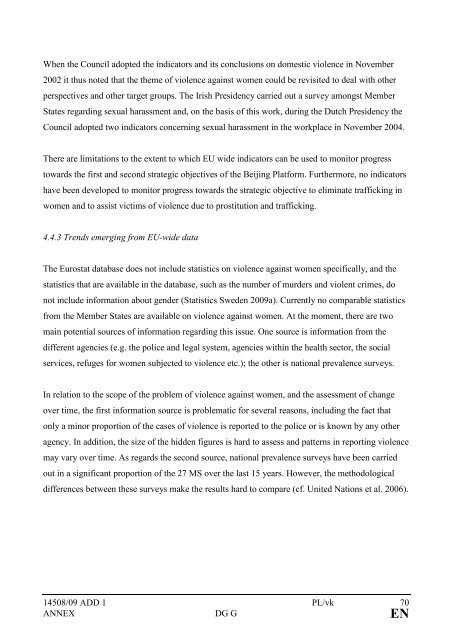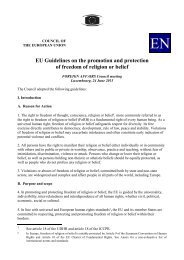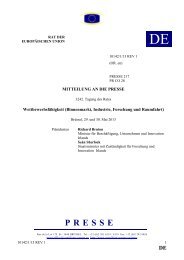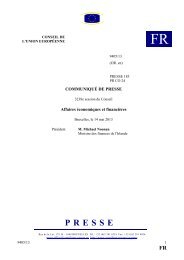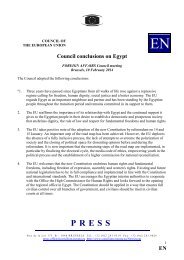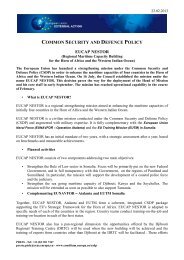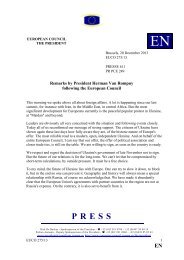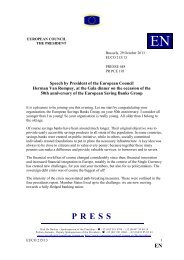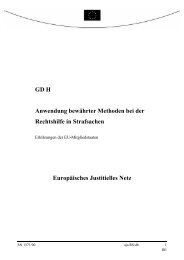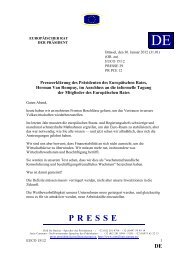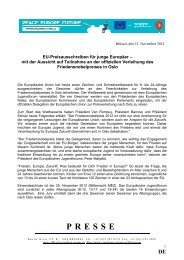14508/09 ADD 1 PL/vk 1 DG G COUNCIL OF THE ... - Europa
14508/09 ADD 1 PL/vk 1 DG G COUNCIL OF THE ... - Europa
14508/09 ADD 1 PL/vk 1 DG G COUNCIL OF THE ... - Europa
Create successful ePaper yourself
Turn your PDF publications into a flip-book with our unique Google optimized e-Paper software.
When the Council adopted the indicators and its conclusions on domestic violence in November<br />
2002 it thus noted that the theme of violence against women could be revisited to deal with other<br />
perspectives and other target groups. The Irish Presidency carried out a survey amongst Member<br />
States regarding sexual harassment and, on the basis of this work, during the Dutch Presidency the<br />
Council adopted two indicators concerning sexual harassment in the workplace in November 2004.<br />
There are limitations to the extent to which EU wide indicators can be used to monitor progress<br />
towards the first and second strategic objectives of the Beijing Platform. Furthermore, no indicators<br />
have been developed to monitor progress towards the strategic objective to eliminate trafficking in<br />
women and to assist victims of violence due to prostitution and trafficking.<br />
4.4.3 Trends emerging from EU-wide data<br />
The Eurostat database does not include statistics on violence against women specifically, and the<br />
statistics that are available in the database, such as the number of murders and violent crimes, do<br />
not include information about gender (Statistics Sweden 20<strong>09</strong>a). Currently no comparable statistics<br />
from the Member States are available on violence against women. At the moment, there are two<br />
main potential sources of information regarding this issue. One source is information from the<br />
different agencies (e.g. the police and legal system, agencies within the health sector, the social<br />
services, refuges for women subjected to violence etc.); the other is national prevalence surveys.<br />
In relation to the scope of the problem of violence against women, and the assessment of change<br />
over time, the first information source is problematic for several reasons, including the fact that<br />
only a minor proportion of the cases of violence is reported to the police or is known by any other<br />
agency. In addition, the size of the hidden figures is hard to assess and patterns in reporting violence<br />
may vary over time. As regards the second source, national prevalence surveys have been carried<br />
out in a significant proportion of the 27 MS over the last 15 years. However, the methodological<br />
differences between these surveys make the results hard to compare (cf. United Nations et al. 2006).<br />
<strong>14508</strong>/<strong>09</strong> <strong>ADD</strong> 1 <strong>PL</strong>/<strong>vk</strong> 70<br />
ANNEX <strong>DG</strong> G EN


